
The title is correct, but its logic is wrong. If you websearch the expression, you will find numerous references to this. It just happens to be wrong and I shall explain. If the level of hoarding was to increase, the volume of Circulating Money would fall causing a recession. I represent this in the following diagram:

It is correct that the onset of a recession is commonly associated with a fall in velocity. However, it is not appropriate to assume that it was the fall in velocity that caused the recession. It is not appropriate to assume that an increase in hoarding caused the recession. The method in the first diagram could feasibly occur, but it would be unnatural. It is possible for our recession to start in a different way. Our velocity decrease can be caused in a much more likely way. A fall in the Money Supply will also cause a recession. This is represented in the following diagram:
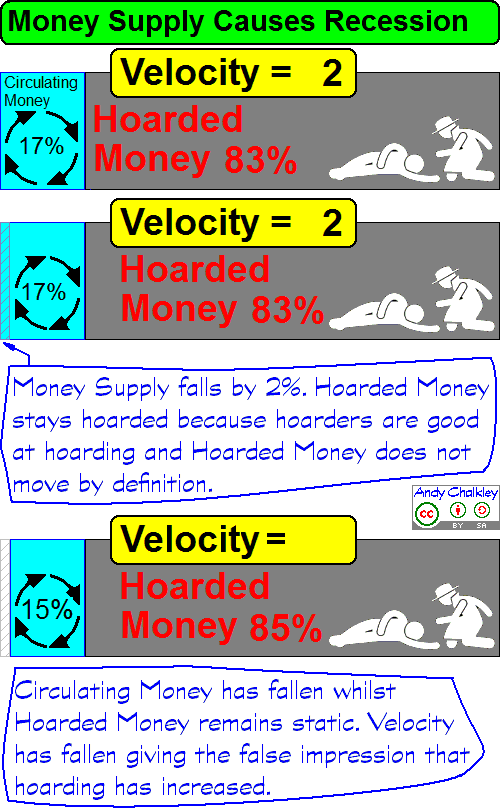
A recession is better characterised as being caused by a fall in Circulating Money. The fall in Circulating Money can be caused by a fall in the Money Supply or less likely by an increase in Hoarded Money. The mechanism that is likely to cause this is now to be discussed. Effectively, we are looking for a cause of the cause and perhaps the cause of the cause of the cause. Not that I wish to be difficult, but some economists say that saving causes a recession. Certainly hoarding can cause a recession, but what causes the hoarding. I can’t see that people would suddenly start hoarding enough to causing a rapid rise in hoarding. The likely scenario is that there is a mild fall in the Money Supply which kicks off a mild recession which encourages persons to hoard money which depletes the Circulating Money further which aggravates the recession. But, what causes the initial fall in the Money Supply? Here we need to know what activities have influence over the magnitude of the Money Supply? We need to know what increases the Money Supply and what reduces the Money Supply.
It is correct that saving/hoarding could cause a recession, but hoarding is unlikely to start on its own. It is likely to occur when a reduction in the Money Supply starts a recession causing citizens to save/hoard. So hoarding amplifies a newly started recession. In Diagram Two, the reduction in the Money Supply caused the Circulating Money to fall, which was reflected by a fall in the velocity. The volume of the Hoarded Money did not fall. The volume of Circulating Money fell, causing a change in the balance in the ratio of Circulating Money to Hoarded Money which is reflected as a fall in velocity. There was no extra hoarding. This is important. It is not saving that increases, but Circulating Money that falls in relation to Hoarded Money. There is generally no fall in Hoarded Money.
Economists are, for the most part, wrong when they say ‘Saving causes recessions’ because it is the Circulating Money. Generally, the volume of Hoarded Money does not rise. No extra saving occurred. It is true that velocity tends to fall during a recession, but that is not necessarily due to an increased volume of savings. Velocity falls because the ratio of Circulating Money to Hoarded Money falls. There may be a subsequent tendency to save (hoard), but that is a separate issue. It is not necessarily correct to say that ‘recessions are caused by increased saving’. That is a red herring likely to take one down inappropriate avenues of investigation in the study of recessions. A fall in velocity is the result of a recession, rather than the cause of a recession.
Study the following graph. Take note of the timing of falls in Money Supply, Circulating Money, and velocity.

In the above graph, although the ‘Circulating Money Percent’ and the Velocity were both falling from about 1995, the actual Circulating Money was increasing, except from about 2008. Even though hoarding was excessive, the constant excessive increase in the Money Supply allowed the Circulating Money to increase even when massive hoarding was occurring. Excessive influence by those who like to ‘make money from money’ and those who worship their ‘net worth’ caused a massive increase in hoarding. But the Circulating Money only fell from about 2008.
Our next activity is to study the mechanism by which a Money Supply might decrease. In the following graph, you can see that the volume of central bank created cash currency (physical money) (coloured orange) is rather small in comparison to the credit stored in bank accounts. When a recession starts, the volume of cash currency does not fall. It remains fairly constant or rises slowly and steadily at the same rate that it usually expands. The volume of green bank credit falls. What are the major ingoings and outgoings from the green section? The government collects tax and spends the tax. Any shortfall is borrowed by issuing bonds. Bonds are purchased using pre-existing bank credit. The bonds are purchased by transferring existing green credit from the purchaser’s account to a government account. This does not alter the volume of green bank credit. The government deficit is somewhat irrelevant in this matter. If the government does need to borrow, it may have an unexpected effect. Even mild borrowing through the issue of shares may alter the composition of the Money Supply. The bank borrows and the sales transaction may be paid from Hoarded Money. The government then spends it into Circulating Money. This process is more likely to raise velocity and increase Circulating Money and reduce Hoarded Money. Deficits are interesting and I shall discuss them in another chapter. The other major ingoing into bank accounts is freshly created bank loans. The other major outgoings are interest and loan repayments. Fresh bank loans increase the Money Supply. Repayments decrease the Money Supply. If fresh bank loans exceed repayments then the Money Supply increases. If repayments exceed fresh loans, then the Money Supply recedes. All that is needed to create a recession is a fall in the rate of issuing fresh loans. This causes the necessary fall in the Money Supply and the fall is logically taken from the Circulating Money. This changes the balance between Circulating Money and Hoarded Money which is reflected as a fall in velocity. Thus economists make an erroneous assumption that it was an increase in saving that caused the recession. Here is a previous graph to study:

In the above graph, it is the fall in Circulating Money that causes the recession. You might also say that the fall in Circulating Money ‘is’ the recession. If the Circulating Money falls, it is a recession almost by definition. There is a smaller volume of monthly transactions. The monthly turnover is reduced. This is the essence of a recession.
The next issue is to study is why there was a fall in bank lending. Banks create credit by book entries. Someone needs to borrow money and the bank creates the credit with a matching debt. Lending would slow if the demand for loans slowed. Reasons could include:
Whatever the reason, the level of bank lending falls whilst banks continue to collect interest and loan repayments causing the Money Supply to fall. People with ‘more money than they can spend’ tend not to borrow as they have plenty of money, so the repayments come out of Circulating Money. The result is a recession.

This understanding will allow you to see at least one simple solution:

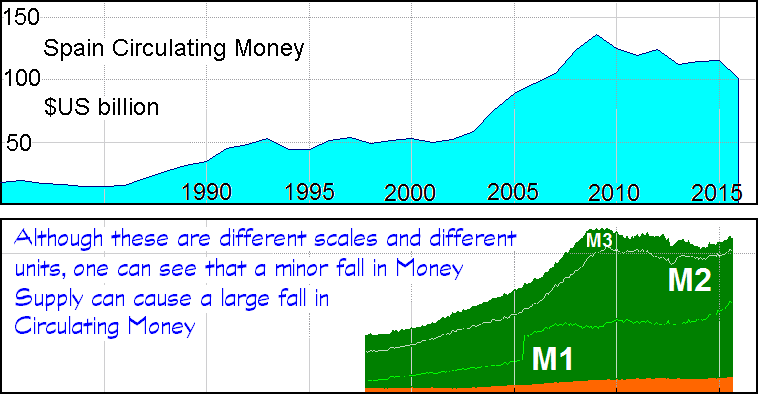
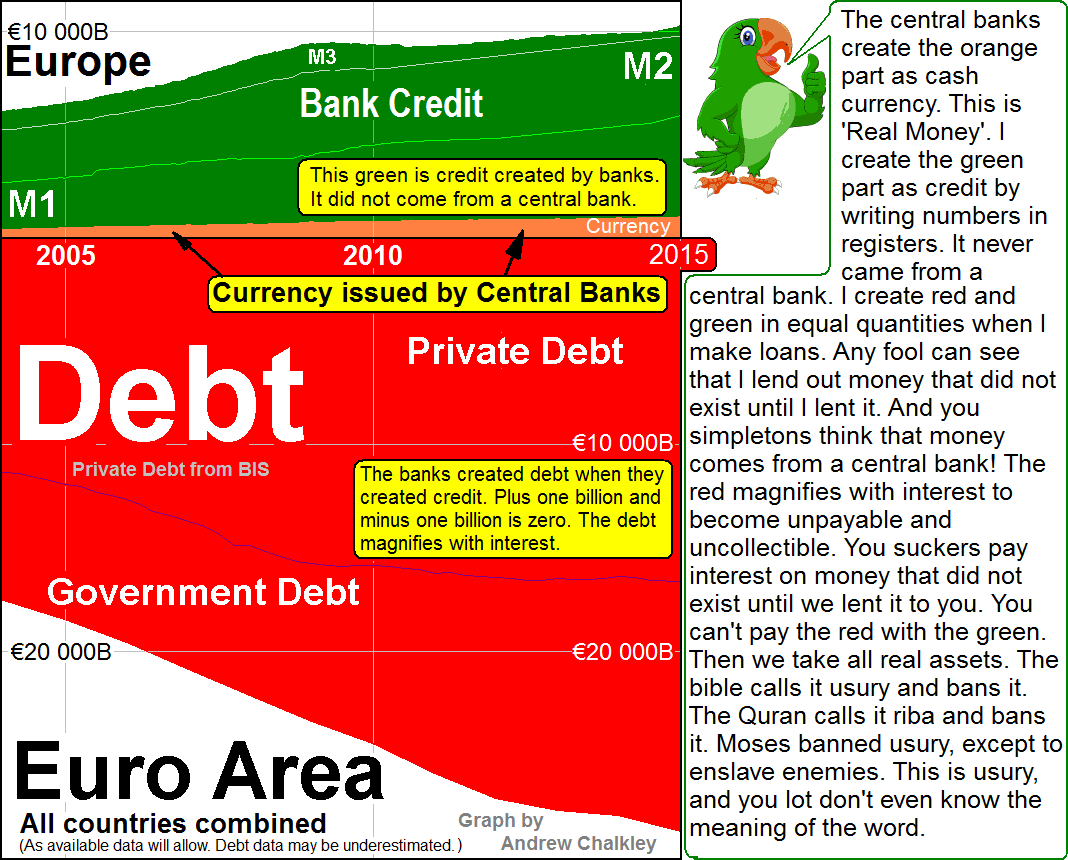
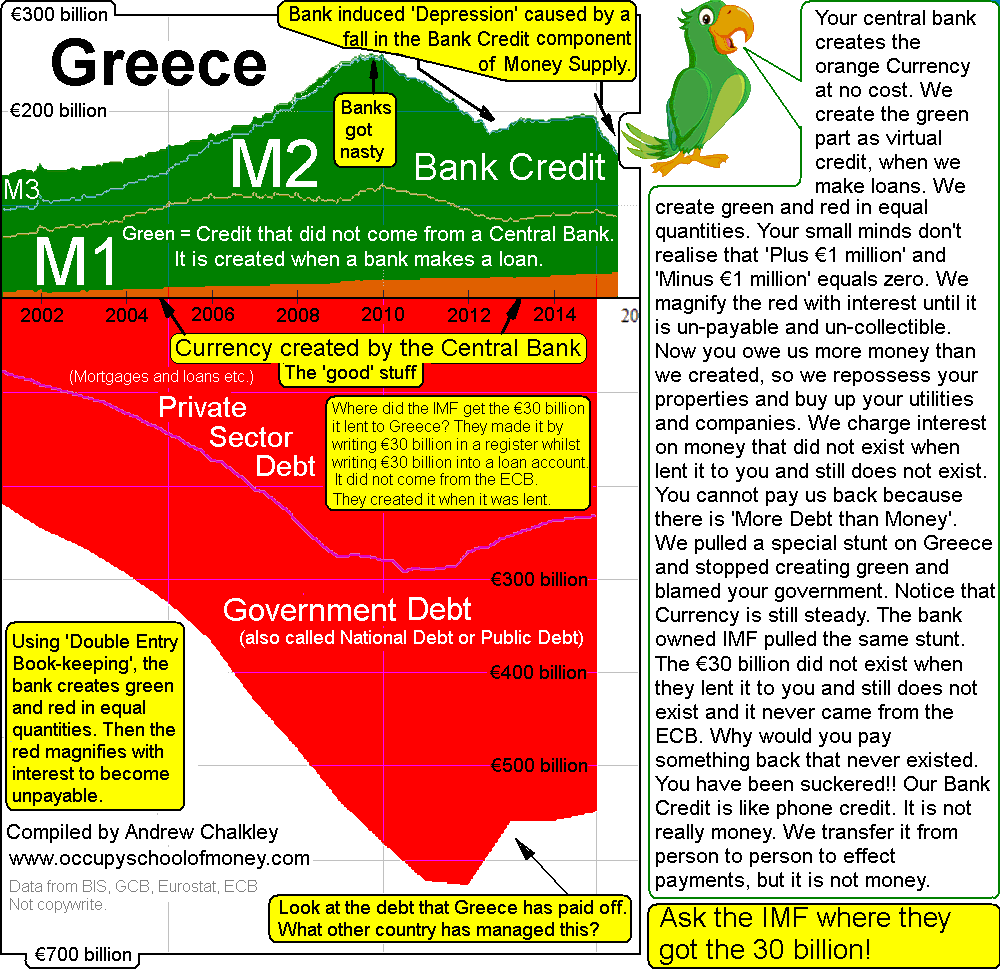



And now a case of a totally useless money regulating agency - commonly known as the ECB. The ECB basically operates with the concept that: “If you want money, borrow it.” This really is not the way to operate a money issuing authority.
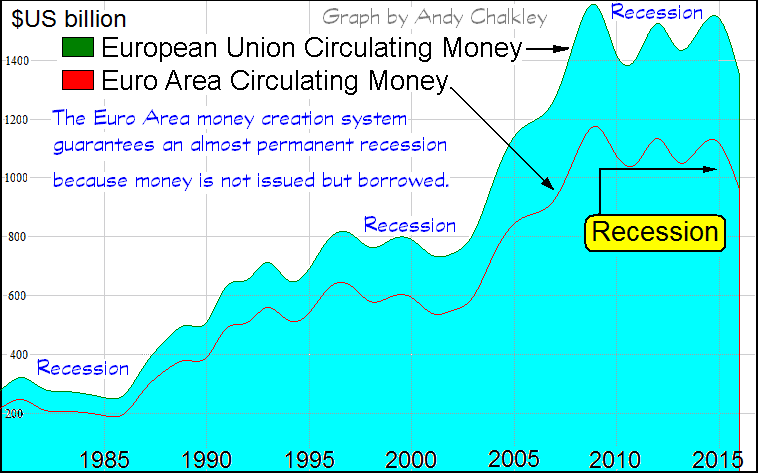

To predict a recession is to keep a close eye on the lending habits of banks. One can monitor monthly statistical data for Circulating Money, which just happens to be the same as monitoring the data for GDP. However, bank lending information should be rapidly available. Monthly lending by banks is a simple area to monitor. When this falls, it will be readily available. When lending falls below interest and loan repayments, a recession is underway. It is also advisable to take note of the areas to which loans are being made. Whichever area receives credit will be enhanced or inflated. An eye kept on the various components of inflation will reveal which areas are being enhanced or inflated. Lending for speculation will do little to enhance the Circulating Money. Lending for housing has a dual effect of increasing the building industry, but also of inflating house prices which will later affect the profitability of business and their willingness to hire. Lending for business entrepreneurial activity will directly enhance the real economy and the GDP. If these are not kept in reasonable balance, a peak or occasionally a bubble will reveal the unsustainability of the then prevalent lending habits of banks.
Be aware that the effects of small falls in Money Supply are far more pronounced in countries with a low-velocity. When the velocity falls to about one, a very small fall in Money Supply can cause a very profound fall in Circulating Money. Low-velocity nations are very sensitive to minor changes in Money Supply and hoarding.

I love that expression where the talking heads spruik: “Keep the central bank free from the influence of politicians.” This is so anti-democratic, yet it is the prevailing attitude. Why do we vote at all, if unelected individuals control the Money Supply? That said, the central bank is charged with control of the Money Supply. It has the blunt instrument of interest rates to control this. They have no system of controlling the volume of loans issued, nor the areas to which they are issued. They have a weak method of influencing the issue of loans through control of the interest rate. This gives the impression that control is being exercised, but the effect is minimal as can be attested by the frequency of fluctuations of the Money Supply and fluctuations of the Circulating Money.
Bank of England 2014 “Is it difficult to believe that the Central Bank with the blunt instrument of interest rate control can control private corporation lending habits. As inflation continues to flourish, their control appears to be a carefully controlled myth.” [1]
John Maynard Keynes wrote of the phenomenon before World War II. He was bright enough to observe an effect, but the study has not progressed much since his time. Some explain his thinking this way: “Recessions occur when individuals start saving (hoarding money) because times are tough – but times become tougher when everyone starts hoarding money.” However, working people do not save when they are broke. They are all in debt, which means they have a negative bank balance. Many say they are broke by the time the next wage arrives. It is not so much an increase in hoarding that is occurring as reflected in the velocity, but a decrease in the Money Supply, that decreases the Circulating Money. The ratio of Hoarded Money to Circulating Money increases even when the Hoarded Money did not increase. A few of Keynes ideas were not quite correct. His concept where governments should borrow and spend the nation out of a recession was profound. But the mechanics of this procedure is somewhat missing. In the old scenario with monarchs creating the coin of the country, the logic is sound. The sovereign would create some more money and spend into society which would directly lift both the Money Supply and the Circulating Money and thus relieve most of the symptoms of the recession. In the modern scenario where the government does not create the money of the nation, and money is borrowed into circulation, Keynes thinking works, but for a different reason. When a government borrows through the medium of issuing bonds, the government is borrowing existing bank credit from affluent persons with excess money. This tends to be hibernating money. Thus hibernating money is turned into Circulating Money. There is no increase in the Money Supply but hibernating money is turned into Circulating Money. When a government borrows from banks or a central bank, the government is borrowing freshly created credit, which causes an increase in the Money Supply and the money is spent into Circulating Money. Keynes is still correct, but for totally different reasons. During the newly coined phrase of ‘Quantitative Easing’, the central bank buys existing ‘assets’ suing freshly created bank credit. There is an increase in the Money Supply, but this is not necessarily going to cause an increase in the Circulating Money. If the freely created credit gets into the hands of the hoarders rather than the small business person and the working class spenders, the fresh credit is likely to become hoarded. This happened after the 2008 debacle. Assets, being government bonds, are purchased from affluent institutions that then sit on the money. ‘Quantitative Easing’ tends not to put money where it is needed which is into the real economy.
A fall in the Money Supply tends to cause the Circulating Money to decrease. This causes the velocity to fall because the ratio of Circulating Money to Hoarded Money to fall. This gives the impression that hoarding has increased. However, the volume of Hoarded Money may not have increased. Only the proportion of Hoarded Money has increased.